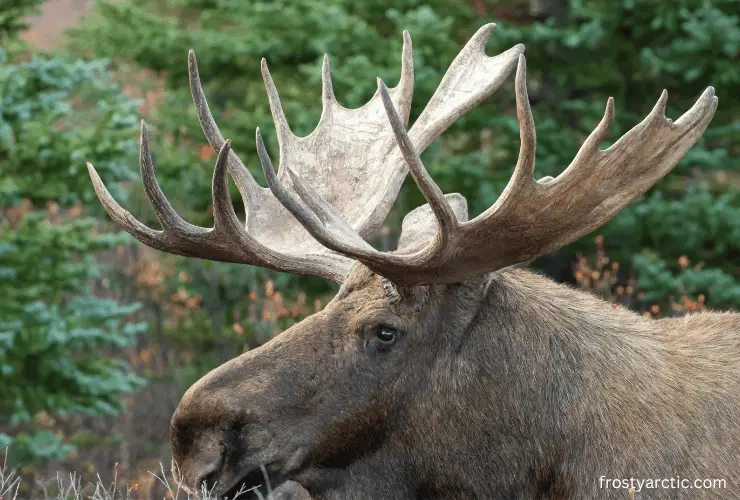A Yukon moose is a large land animal that lives in the western part of Canada. These animals are found mainly in the Yukon Territory and Northwest Territories, but they also have been found in Alaska.
Their coats are thick and plush, and they often have patterns of brown or black spots. Yeah!! It’s truly a wild flavor when talking about Yokon moose and their size.
Existence of Yukon Moose: A Detailed History and Guide
Here’s a bit of information on the lives of Yukon Moose:
Scientific name: Alces Alces Gigas
Height: 6.5 feet or 2 meters (Male), 6 feet or 1.8 meters (Female)
Mass: 1200 lbs to 1800 lbs (Male), 800 lbs to 1200 lbs (Female)
Speed: 35 Miles per hour (Top Speed)
Eaten by: Predators and Humans (Food)
Lifespan: 12 to 15 Years
Predators: Wolves, Bears, Coyotes.
Symbolism: Pride and Nobility.
Mating season: September and October.
a) Yukon moose size
The Yukon Moose is the largest subspecies of moose, known for its impressive size. Adult males, also known as bulls, can weigh up to 1,500 pounds (680 kg) and stand up to 7 feet (2.1 m) tall at the shoulder.
They have a body length of up to 8.5 feet (2.6 m) and a tail length of up to 20 inches (51 cm). Adult females, also known as cows, are slightly smaller, can weigh up to 1,200 pounds (544 kg), and stand up to 6.5 feet (2 m) tall at the shoulder. They have a body length of up to 7.5 feet (2.3 m) and a tail length of up to 18 inches (46 cm).
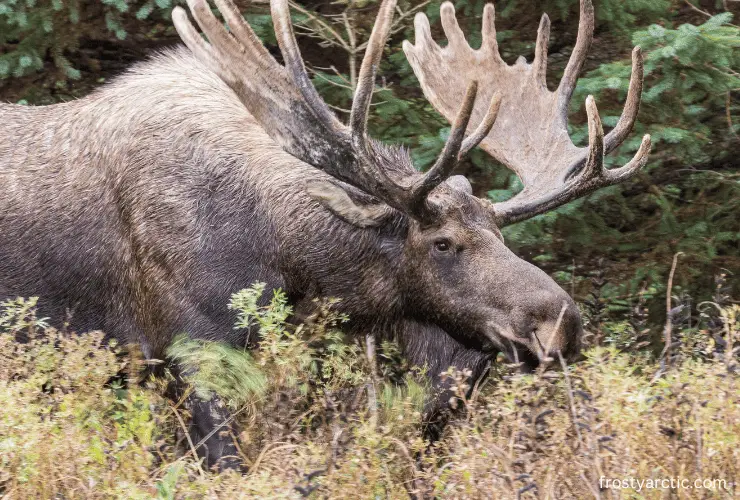
In comparison, young moose or calves are significantly smaller. At birth, moose calves weigh around 25-35 pounds (11-16 kg) and are around 2.5-3 feet (0.75-0.9 m) tall at the shoulder.
They grow rapidly, gaining up to 3 pounds (1.3 kg) per day during their first month. By the end of the first year, they are around 4-5 feet (1.2-1.5 m) tall at the shoulder and weigh around 300-400 pounds (136-180 kg). It takes a few years for them to reach their full adult size.
It is important to note that the size of the Yukon Moose can vary depending on the location and food availability. Moose in areas with abundant food sources tend to be larger than those with less food.
b) Yukon moose range and distribution
Range
The Yukon Moose (Alces alces gigas) distribution is primarily in the northern regions of North America, including the Yukon territory of Canada. They also occur in Alaska, British Columbia, Northwest Territories, Nunavut, and the western portions of Alberta, Manitoba, and Saskatchewan.
Historically, they also have been found in some parts of the continental U.S., specifically Montana, Idaho, and Washington.
Still, the subspecies’ population is no longer found in the United States due to habitat loss, hunting, and other human activities.
Distribution
Yukon Moose typically inhabit boreal forests, taiga, and tundra ecosystems and are generally found in wooded areas but also frequently frequent swamps and wetlands. They can swim long distances and are known to cross rivers and lakes in search of food.
They are also known to move to higher elevations in the summer and to lower elevations in the winter in search of food. The Yukon Moose population is currently stable, but hunting is regulated in the region to ensure sustainable hunting.
c) Yukon moose morphology and behavior
Morphology
The morphology of the Yukon moose, Alces alces gigas, is characterized by its large size and long legs. Adult males can weigh up to 1,500 pounds and stand up to 6.5 feet tall at the shoulder. They have a large, bulbous snout and a wide, palmate antler structure.
Their coat is dark brown and thicker and longer in the winter to protect against the cold. Adult females are slightly smaller than males and do not have antlers.
Overall, the Yukon moose is well-adapted to its northern habitat, with physical characteristics that help it survive in cold, snowy environments.
Behavior
The behavior of Yukon moose is influenced by their environment and the year’s seasons. Some general behaviors of the moose include:
- Foraging: Yukon Moose are primarily herbivores and spend much time foraging for food. They will eat a variety of plants, including willow, aspen, and balsam poplar, and will also eat aquatic plants when they are available.
- Solitary: Yukon Moose are generally solitary animals, except during the mating season when bull moose compete for access to females.
- Territorial: Male moose can be territorial during the mating season and will defend their territory from other males.
- Migration: Moose may move to different areas in search of food or to find suitable mating partners.
- Hibernation: Moose do not hibernate but become less active during the winter when food is scarce.
- Adaptability: Yukon Moose can adapt to various habitats, from forests to wetlands, and survive in cold and warm climates.
- Aggression: Yukon Moose can be unpredictable and aggressive if they feel threatened. They may charge at anything that gets too close, especially during the mating season.
- Swimming: Yukon Moose are excellent swimmers and can cross large rivers and even swim several miles out to sea.
Importance of Yukon Moose (Yukon Moose and Its Antlers)
a) Importance of Yukon Moose
Yukon moose is important for several reasons:
- Ecological: They are a keystone species in the northern ecosystems, playing an important role in shaping the landscape and supporting other species.
They help maintain the forests’ biodiversity by eating and trampling on vegetation, creating openings for new growth and allowing other animals to thrive.
- Cultural: Moose has been an important part of the culture and subsistence of many Indigenous peoples in the Yukon and Alaska for thousands of years. They provide many communities with food, clothing, tools, and spiritual significance.
- Recreational: Moose hunting and viewing are popular activities in the Yukon, bringing tourism and economic benefits to the region.
- Scientific: Moose populations in the Yukon provide valuable opportunities for scientists to study the effects of climate change on large mammals and their ecosystems.
Overall, the Yukon moose are an important part of the northern ecosystem, culture, and economy and for scientific study. They play a vital role in the biodiversity and subsistence of the region.
b) Importance of Yukon Moose Antlers
The antlers of Yukon moose play several important roles:
- Reproduction: In males (bulls), large antlers are used as a secondary sexual characteristic to attract females (cows) during the breeding season. Antlers can also be used in competition with other males to access mates.
- Defense: Antlers can be used as a weapon to defend against predators or Food. Antlers are a source of calcium for animals that eat them, such as porcupines and squirrels.
- Cultural: Moose antlers are important in many Indigenous cultures and are used to make tools, weapons, and ceremonial objects.
- Recreational: Moose hunting is an important recreational activity in the Yukon, and the size of the antlers is an important factor in determining the trophy quality of the animal.
- Scientific: Antlers can indicate the moose’s health, age, and nutrition. The growth pattern and size of antlers can be used to track the health of moose populations, and the study of antlers can give insights into the moose’s overall ecology and biology.
The Population of Yukon Moose
It is difficult to estimate the exact population of Yukon moose in the world, as populations can fluctuate due to factors such as hunting, habitat loss, and climate change.
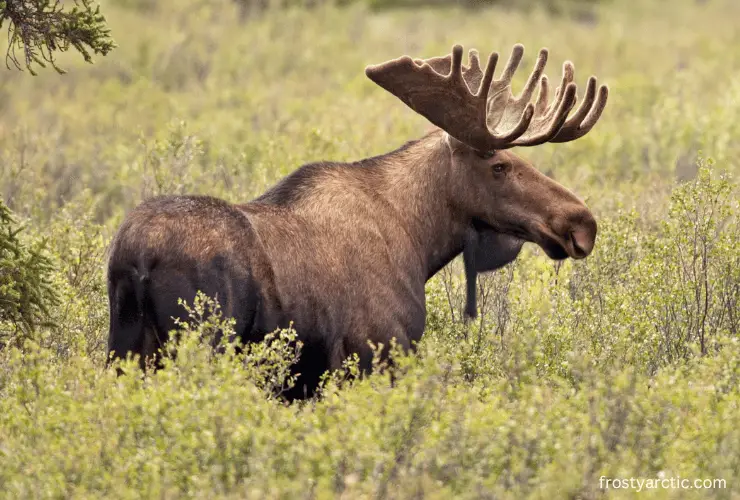
However, it is generally considered a relatively stable species with a wide distribution across the northern regions of North America, including Alaska, Canada, and some parts of the contiguous United States.
In Canada, the population of the Yukon moose is estimated to be around 200,000 Moose. The population in Alaska is also substantial, with an estimated population of around 150,000-200,000 Moose.
Yukon Moose Diet
The diet of a Yukon moose varies depending on the year’s season:
- In the spring, moose will feed on new growth of willows, aspen, and balsam poplar. These plants are protein-rich and provide the moose with the necessary nutrients to grow and recover from the winter.
- In the summer, moose will continue to eat willows, aspen, balsam poplar, and other vegetation such as ferns, grasses, and aquatic plants.
- They also consume aquatic plants, such as lilies and pondweed, which are abundant in the many ponds and wetlands that are common throughout their range.
- In the fall, moose will eat more woody plants, such as birches, dogwoods, and alders, which are high in carbohydrates. This helps them to build up fat reserves for the winter.
- In the winter, moose will feed on woody plants such as balsam fir, spruce, and willow, which are rich in protein and help them to survive the harsh winter conditions. They will also forage for lichens and mosses, which are abundant on the forest floor.
Overall, the diet of a Yukon moose changes throughout the year, reflecting the availability of different vegetation types. They are opportunistic feeders and will take advantage of whatever food is available to them in their environment.
Is It Illegal to Hunt Yukon Moose?
The legality of hunting Yukon moose varies depending on the jurisdiction and the specific laws and regulations in place:
In general, hunting Yukon moose is legal in Alaska, Canada, and some parts of the contiguous United States. Still, restrictions and regulations are in place to ensure sustainable hunting and population management.
In Alaska, moose hunting is legal and regulated by the Alaska Department of Fish and Game, with hunting seasons and quotas established based on population estimates and management goals.
In Canada, moose hunting is also legal and regulated by the provinces and territories, with hunting seasons and quotas established by the governments of each jurisdiction.
It is important to check with the local wildlife agency or department to confirm the legality of hunting Yukon moose and obtain the necessary licenses and permits.
Mating Season of Yukon Moose
The mating season of a Yukon moose, also known as the rut, typically takes place in September and October. During this time, Yukon moose will compete for access to females by displaying their large antlers, bellowing, and engaging in fights with other males.
During the rut, bull moose will become more aggressive and may charge at anything that gets too close. Cows will come into estrous for a short period of time and will be receptive to mating during this time. After mating, the cows will carry the fertilized eggs for about 230-240 days until the calf is born in spring or early summer.
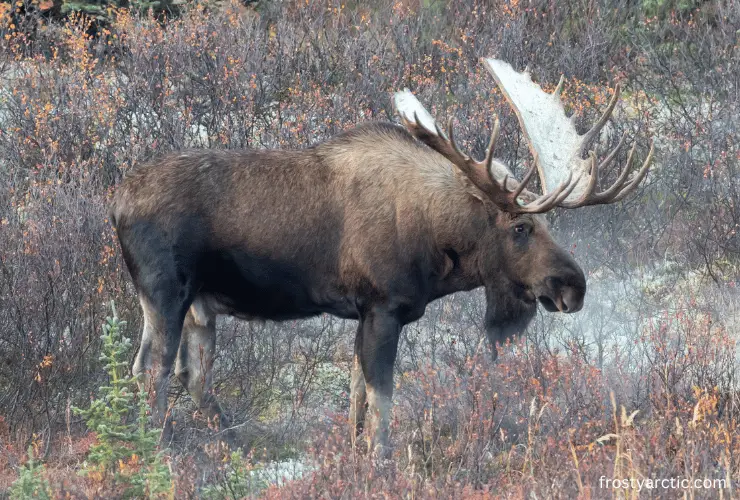
The exact timing of the rut can vary depending on factors such as location, weather, and food availability. In areas with abundant food, the rut may occur earlier, while in areas with less food, it may occur later.
It’s worth noting that, overall, the population of the Yukon moose is stable, but local populations may be impacted by factors such as hunting, habitat loss, disease, and climate change.
Yukon Moose Vs. Shiras Moose
The Yukon moose are found in the northern regions of North America, including Alaska and Canada. It is the largest subspecies of moose, with adult males weighing up to 1,500 pounds and standing up to 6.5 feet tall at the shoulder.
They have a large, bulbous snout and a wide, palmate antler structure. Their coat is dark brown in color.
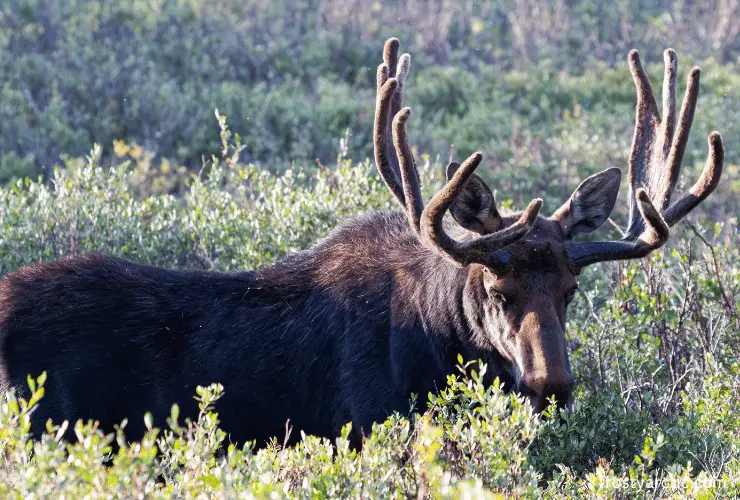
The Shiras moose, also known as the Wyoming moose, is found in the western United States, including Wyoming, Montana, Idaho, and Colorado. It is smaller than the Yukon moose, with adult males weighing up to 1,200 pounds and standing up to 6 feet tall at the shoulder.
They have a narrower snout and a smaller, palmate antler structure. Their coat is lighter in color than the Yukon moose.
FAQ
Which country has the most population of Yukon moose?
The Yukon Moose is a subspecies of the Alaskan Moose. So, Canada has the most population of Yukon Moose.
Yukon Moose can be found in various areas of the Yukon territory in Canada, such as:
- Whitehorse area: This is the capital city of the Yukon, surrounded by wilderness areas that are home to many Moose.
- Southern mountain ranges: The southern mountain ranges of the Yukon, such as St. Elias and Coastal mountains, provide a suitable habitat for Moose and are home to many animals.
- The Mayo area: The Mayo area has a good density of Moose population
Is Yukon moose considered an endangered species?
The Yukon Moose is not considered an endangered species. It is considered a species of “Least Concern” by the International Union for Conservation of Nature (IUCN).
This means that the population of the Yukon Moose is stable and not at risk of extinction in the near future.
However, the population of the Yukon moose may have been affected by hunting pressure, habitat destruction, climate change, and diseases over the years.
What is the largest Yukon moose ever found?
The largest Yukon Moose ever found was in the Yukon, which was 7.6 feet tall and weighed over 1806 lbs.
Conclusion
Here are some fun facts about the Yukon Moose:
- Moose have a keen sense of smell, but their eyesight and hearing could be better. They rely on their sense of smell to find food and avoid danger.
- Moose are solitary animals that mainly come together during the breeding season.
- Moose have a short mating season which runs from September to October, and the females give birth to one or two calves the following May or June.
- Moose are known for their distinct call, which sounds like a bellow or a roar.
- Moose are slow runners but are known for their aggressive behavior when threatened, so it’s best to keep a safe distance from them.

